Mar 2013
Light Sources Part I – LED’s
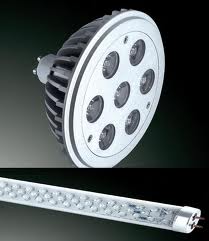
There is a lot of buzz these days in the lighting industry about LED, technically know as Solid State Lighting. Everybody is jumping onto the LED bandwagon. I get emails everyday from manufacturers from the Far East trying to sell me their LED products. Beware, there is a lot of bad LED product in the marketplace. Conversely there is a lot of good LED product available too. Hopefully this posting will enable you to distinguish between the two.
LED is an energy efficient light source that may or may not be dimmable. Check the product information to be sure. It is a product with a long life. Manufacturers claim up to about 27 years under normal operating conditions. The light output degrades slowly over the life of the LED meaning it does not burn out all of a sudden.
An LED is a Light Emitting Diode, a simple type of semiconductor that is similar to semiconductors used in computers. It is a solid material that conducts electrical current. Light is emitted from the semiconductor die which is a chip of semiconductor material treated to create a positive-negative junction. When voltage is applied the current flows from the positive to the negative side and excess energy is emitted as a photon and heat is emitted in the form of conduction. The natural color of the photon is not white. What we see today as LED lights require the LED to be coated with different materials to give white light (as well as many other colors). LED’s are a directional light source by nature. They emit light in one direction. In order for an LED bulb to emit light like an incandescent light bulb reflectors must be used inside the LED capsule. That’s the technical stuff.
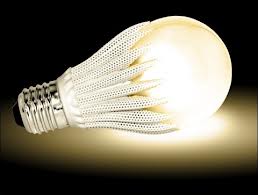 |
| Typical LED replacement light bulb. |
Looking at the picture to the left you will see a typical LED replacement light bulb. Notice the fins on the bottom of the bulb. They serve as the heat sink. This is probably the equivalent to a 40 watt incandescent light bulb. Inside are many individual LED chips arranged in an “array” to product sufficient light output to generate about 800 lumens. The reason you have not seen any 100 watt equivalent LED replacement bulbs is because they have not figured out how to dissipate the heat that would result in generating about 1,600 lumens. Imagine a heat sink twice the size of this one! You could not get the light bulb into the socket.
 |
| Examples of directional and under cabinet LED’s. |
Looking at the photo to the right you will see an example of an LED replacement directional light bulb, probably replacing a PAR30. The fins on the back are the heat sink. Below that is an example of an under cabinet linear LED fixture comprised of many LED chips. They are arrayed in a linear fashion to provide a even distribution of light on a counter top. This type of linear fixture can also be used as cove or toe kick lighting. In my opinion the best residential application today for LED lighting is this type of under cabinet lighting.
There are a few things you should be aware of when considering LED lighting for your home.
First is the cost. The payback period for LED vs incandescent is between 4 to 7 years. LED technology is doubling about every 18 months following Moore’s Law. This means a couple of things for you. First, prices are sure to come down in the next few years. Second, new and better LED products are going to be available in the next few years. Imagine LED technology being like computer technology in the 1980’s. So the question is: Do you wait or do you jump in now, knowing that the product you buy today will be far surpassed in the next few years? Keep in mind that these LED’s will supposedly last for up to 27 years under normal operating conditions and hours. Conversely if everybody had waited for computer technology to improve before jumping in, the technology might have stalled. The benefits of buying LED now, like energy conservation, might outweigh the uncertainty of what future LED technology will be.
The next thing you need to be aware of is quality. There are HUGE quality differences in today’s LED products. These differences could ruin your LED lighting experience if you do not do your homework. LED’s are manufactured by lots of different companies in lots of different factories all over the world. Like everything else some factories have better quality control than others. Individual LED chips have individual properties that distinguish them from each other. Good quality control means that LED’s with the same characteristics are grouped (binned) together. This means the LED’s with the same color qualities and same lumen output should be used to make a fixture or replacement bulb. These will perform as they are rated to perform. Also as with anything else a low price might be a red flag.
Color temperature and CRI (reference my previous posting) are two of the big considerations. If you get an LED with the wrong color temperature it can feel like you are living in a parking garage. If you get one with poor CRI you will be very disappointed about how items in your home look. Maybe the drapes on your windows will look green instead of orange. Remember CRI should be in the mid-80’s and color temperature should be around 3000K for relaxing light.
Lighting in your home is a big deal. My advice would be to try LED and see how you like it before going all in, and get the best you can afford.
Please visit my website, fogglighting.com, and email me with any questions. I do not have all the answers, but I know where to get them.
Mar 2013
Some Qualities of Light That You Should Know
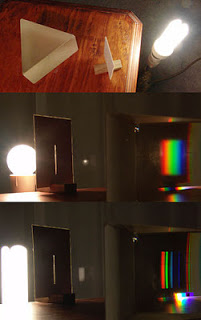
Before my first posting about light bulbs (sources of light) there are some qualities of light with which you should become familiar. Different sources of light exhibit different characteristics that influence which light bulb to use in different situations.
Color Temperature is a term that refers to the color of light, commonly expressed as warm or cool. Technically it is expressed in degrees Kelvin (K) with lower numbers being warmer than higher numbers. For example 1,700K is the color of a flame, 2,700K is the color of an incandescent light bulb, 3,000K-4,500K is the color temperature of fluorescent and LED light sources and 6,500K is the color temperature of the sun on an overcast day. For residential lighting purposes most color temperatures are compared to incandescent light.
 |
| Notice the smooth transition from red to violet for the incandescent light bulb. |
Color Rendering Index, expressed as CRI, is a measure of how good colors look. All light bulbs are compared to an incandescent light bulb which is deemed to have the best CRI. CRI is expressed by a number from 1 to 100, 100 being the CRI of an incandescent light bulb. CRI’s between 82 to 100 are judged to be satisfactory while CRI’s below 80 are not. Most of the new fluorescent light bulbs, including CFL’s, are mid 80 or higher. LED’s currently range from about 65 to 88. In the photo to the left you can see the full spectrum in the light of the incandescent light bulb earning it it’s 100 CRI rating.
As humans our eyes see color as the reflection of the color in the light source. If part of the color spectrum is missing from a light source, red for example, you will not see red. Some of the early highway lighting had such bad CRI that at an accident scene the police could not differentiate between blood and oil.
There is a lot to learn about light, how we see light, how contrast affects how we see, how glare interferes with our vision and what kind of light is best for different situations. I strongly urge you to download the Underwriters Laboratory app “Light Smart” at the App Store. It has lots of great information about lighting.
Please visit my website, FoggLighting.com.
Mar 2013
Best Uses of Recessed Lighting
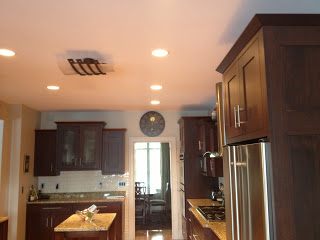
Recessed lighting is best used for task lighting, wall lighting and accent lighting. Since recessed lighting can be directional, the light can be directed onto a work surface, or onto a wall or onto a piece of art. It is a tool that makes tasks visible, that washes an interesting feature on a vertical surface or that lights a painting or a sculpture. The most important part of the recessed fixture is the light bulb. The choice of the correct light bulb is crucial in creating the desired effect. The first decision any lighting designer makes is which light bulb to use. Fixture selection is secondary. Light bulb selection will be discussed in a future posting.
 |
| Improper Placement Of Recessed Lights |
The kitchen pictured here is an example of task lighting gone wrong. The recessed lights look great and are supposed to illuminate the kitchen. They do illuminate the center of the kitchen. However, working at the counters along the sides of the kitchen is difficult because shadows are created on the work surface by having the light come from behind. Recessed lights in a kitchen should be aligned with the front edge of the counter tops to avoid this pitfall. This is the most common mistake made with recessed lighting, improper placement.
Lighting art is also a matter of proper placement. The recessed light must be directional, use the correct light bulb and be positioned at the correct distance from the wall so that the light hits the painting at a 30 degree angle. This is a function of ceiling height and the height at which the art is hung. The correct angle is important because when light from a light source strikes a surface light is reflected off that surface. The 30 degree angle insures that the reflected light does not shine back into the viewer’s eyes.
Lighting a wall is a terrific way to create interest in a feature, a fireplace or an accent wall. It also is a way to get more ambient light into a room. Placement and the correct fixture/light bulb combination is important here too. Usually the fixture will be placed close to the wall and shine straight down. Using this method of lighting adds depth to a room and increases visual interest.
I do not like using recessed lighting in living areas where people gather and sit and interact because light from above creates unattractive shadows on faces. Use recessed lights along the perimeter of these spaces if you use it at all.
Please visit my web site when time permits.
Mar 2013
The Cost of Recessed Lighting
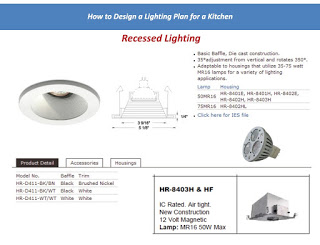
 |
| Examples of Recessed Lighting |
Recessed lighting can be a cost effective way to light some of the rooms in your house. The fixtures range in price from about $25 to $500 depending on aperture size, light bulb used, features, components and manufacturer. Electricians will typically charge anywhere from $50 to $250 to install each fixture depending on the complexity of the installation.
The most common and least expensive recessed fixture is the 6″ can with a white baffle trim. These are usually lamped with a BR (Bulge Reflector) light bulb which gives a wide glow of light but which also causes glare because the bottom of the light bulb is level with the plane of the ceiling. Other commonly used residential recessed fixtures are the 3″, 4″ and 5″ aperture models which used CFL’s, A-Lamps (regular light bulbs), LED’s, PAR16, PAR20, PAR30 or MR16 light bulbs. Prices of these models depend primarily on the internal components which influence photometrics and aiming ability.
LED recessed lights are among the most expensive. They come in many variations. Some have a dedicated LED light source built in, some have LED inserts that can be removed. There are also LED light bulbs that can be used in existing recessed fixtures if you want to conserve energy. These range in price from about $25 to $75. The payback period on LED’s is generally measured in years. The latest figure I heard was anywhere from 5 to 7 years. As LED prices come down, which they will, the payback period will become shorter and shorter.
I will discuss more about recessed lighting in my next posting. In the meantime please visit my website. Thank you.
